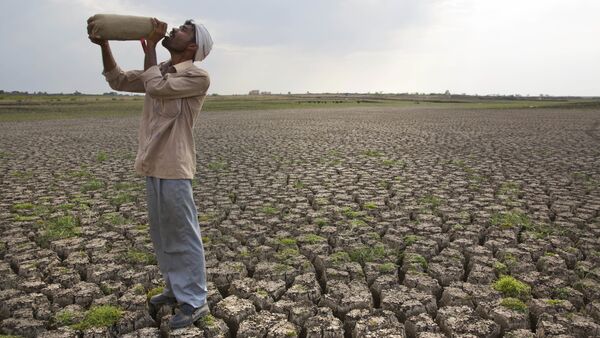New Delhi (Sputnik) — A comprehensive report published by the NITI Aayog, the Indian government's main policy think tank, indicates that at least two hundred thousand Indians die every year due to inadequate access to potable water. According to the new projections, the crisis is going to continue to worsen until 2030, leading to an eventual 6% loss in the country's national income.
READ MORE: Global Shortage of Key Resource Could Doom Key Asian Infrastructure Projects
"India is suffering from the worst water crisis in its history and millions of lives and livelihoods are under threat. Currently, 600 million Indians face high to extreme water stress and about 200,000 people die every year due to inadequate access to safe water," says NITI Aayog.
NITI Aayog has developed the Composite Water Management Index (CWMI) to enable effective water management in Indian states in the face of the growing crisis.
Among the states of India, Gujarat is the best performer in the #WaterIndex, closely followed by Madhya Pradesh, Andhra Pradesh, Karnataka, Maharashtra & Telangana.
— NITI Aayog (@NITIAayog) June 14, 2018
Read more: https://t.co/RfdJl7aIhP pic.twitter.com/Jc5RhgaAZ8
The Composite Water Management Index (CWMI) is a first-of-its-kind, comprehensive scorecard for identifying, targeting, and solving problems in the water sector across the country.
Water is the biggest challenge India faces. 600 mln people face high to extreme water stress The #WaterIndex released by Niti covers 28 indicator & ranks States on performance. Low performers are home to 50% of country’s population. Significant water risks faced by country.
— Amitabh Kant (@amitabhk87) June 14, 2018
The report also highlights the grave problem in rural India, wherein around 70% of country's population, approximately 800 million people, reside. Currently, only half of the rural population has access to safely-managed water, which is far behind China and Bangladesh, resulting in among of the highest disease burdens due to water-borne diseases in the developing world.
READ MORE: Scholars Mull Project to Divert Water from Tibet to Arid Xinjiang
NITI Aayog has termed this as "one of the largest service delivery challenges in the world in terms of scale."
Niti Aayog reports that our Jharkhand state is one of the bottom 5 states on Water Resource Management.
— Sameer Bhagat (@iSameerBhagat) June 16, 2018
No wonder, this summer, our Ranchi saw unprecedented water shortage crisis and this grave situation is likely to get worse in coming future.
News: https://t.co/MyHyUH0Sy1 pic.twitter.com/SmPQaUrYRM
While urban water access is high on average, significant gaps remain across the country, and wastewater treatment remains stuck at the national average of approximately 33%.



